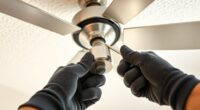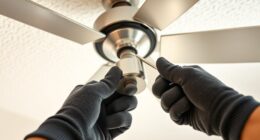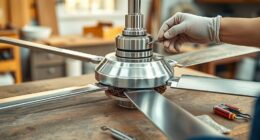To prevent ceiling fan motor overheating, ensure the blades are balanced and unobstructed to reduce motor load, and regularly clear dust or debris from the motor housing to enhance airflow. Maintain secure electrical connections, prevent voltage fluctuations, and replace worn capacitors to avoid irregular current flow. Adequate ventilation around the fan and functioning thermal protection also help dissipate heat. Following these steps can optimize motor performance; further tips will help you keep your fan running cool.
Key Takeaways
- Regularly clean dust and debris from the motor and vents to improve airflow and cooling.
- Ensure blades are balanced and unobstructed to reduce motor load and heat buildup.
- Check electrical connections and replace faulty capacitors to prevent irregular current and overheating.
- Improve room ventilation and avoid high ambient temperatures around the fan.
- Use the fan at moderate speeds and allow rest periods to prevent thermal stress on the motor.

Ceiling fan motor overheating can pose significant safety and performance risks, potentially leading to motor failure or fire hazards. When a motor operates at elevated temperatures, it accelerates insulation degradation, which can result in short circuits or complete motor failure. Overheating also compromises the internal components, reducing the fan’s lifespan and increasing the likelihood of electrical faults. To prevent such issues, you must understand the core causes of motor overheating and implement effective preventative measures.
Overheating motors risk failure, fires, and reduced lifespan; understanding causes is key to prevention.
One primary factor contributing to overheating is excessive load. If the fan blades are unbalanced or obstructed, the motor works harder to turn the blades, generating additional heat. Regularly inspecting and balancing the blades ensures smooth operation and minimizes undue stress on the motor. Additionally, accumulated dust or debris within the motor housing impairs airflow, trapping heat and elevating operating temperatures. Routine cleaning of the motor and surrounding components removes obstructions, allowing proper ventilation and heat dissipation.
Electrical issues also play a significant role. Voltage fluctuations, poor wiring, or faulty capacitors can cause irregular current flow, leading to inconsistent motor operation and overheating. Confirm that the electrical connections are secure and that the power supply remains stable. Replacing worn or damaged capacitors prevents excessive current draw, which can generate heat. Proper wiring practices, including using appropriate gauge wires and avoiding loose connections, help maintain electrical stability and reduce thermal stress.
Ventilation and cooling are vital factors in preventing overheating. Many ceiling fans incorporate vents or cooling fins designed to facilitate heat transfer away from the motor. Ensuring these vents are unobstructed and free of dust enhances airflow. If your fan has a built-in thermal overload protector, verify that it functions correctly, as it automatically disconnects power when temperatures exceed safe limits. Installing additional cooling measures, such as using fans or ensuring adequate room ventilation, can help maintain ideal operating temperatures.
Operational parameters also influence motor temperature. Running the fan at high speeds continuously or frequently switching it on and off can cause temperature fluctuations, leading to thermal fatigue. Operating the fan at moderate speeds and allowing periods of rest help maintain a consistent, safe operating temperature. Additionally, if the fan is mounted in an environment with high ambient temperatures or poor ventilation, consider relocating it or improving the room’s airflow to reduce thermal buildup around the motor.
Maintaining proper ventilation and cooling not only prevents overheating but also extends the overall lifespan of the fan motor.
Frequently Asked Questions
How Long Should a Ceiling Fan Motor Last With Proper Maintenance?
A ceiling fan motor typically lasts 10 to 15 years with proper maintenance. Regularly clean the blades and motor housing to prevent dust buildup, lubricate moving parts if applicable, and guarantee the wiring is intact. Avoid overloading the fan and operate it within recommended speed settings. Timely inspections and addressing minor issues early can extend the motor’s lifespan, ensuring efficient performance over the years.
Can Installing a Larger Fan Prevent Overheating Issues?
A larger fan acts like a broader shield, dispersing heat more effectively than a smaller one. By increasing blade size and motor capacity, you improve airflow, reducing the risk of overheating. This added capacity helps the motor handle higher loads without excessive heat buildup. Selecting a fan with appropriate size and power ratings guarantees efficient cooling, preventing thermal stress and prolonging motor lifespan through better heat dissipation.
Are There Specific Brands Known for Better Motor Cooling?
Some brands like Hunter, Minka-Aire, and Casablanca are known for better motor cooling due to advanced ventilation systems and high-quality components. These manufacturers often incorporate features such as optimized airflow design and thermal protection circuitry, reducing overheating risks. When selecting a fan, prioritize models with these features, and verify proper installation and maintenance to maximize motor lifespan and performance.
How Does Altitude Affect Ceiling Fan Motor Performance?
At higher altitudes, you’ll notice ceiling fans struggle more like Icarus flying too close to the sun, due to thinner air reducing cooling efficiency. The reduced air density diminishes the fan’s ability to dissipate heat, risking motor overheating. To counteract this, make certain your fan’s motor is rated for high-altitude operation or install a fan with enhanced cooling features. Proper maintenance and selecting altitude-appropriate models help maintain ideal performance.
What Are the Signs of Impending Motor Failure Due to Overheating?
You’ll notice the motor makes unusual noises, such as squealing or grinding, indicating stress. The fan may wobble or run intermittently, and the motor could emit a burning smell. Overheating can cause the motor to shut off unexpectedly or produce excessive heat on the casing. If you observe these signs, turn off the fan immediately to prevent further damage and inspect or replace the motor as needed.
Conclusion
To guarantee your ceiling fan motor remains cool and functions at its best, consistent maintenance is essential. Regularly check for dust buildup, lubricate moving parts, and ensure proper ventilation. Neglecting these steps could lead to unexpected overheating, risking motor failure. Will your next inspection reveal hidden issues before they escalate? Stay vigilant—preventative measures today could save you from costly repairs tomorrow. Don’t wait until it’s too late; keep your fan running smoothly and safely.









